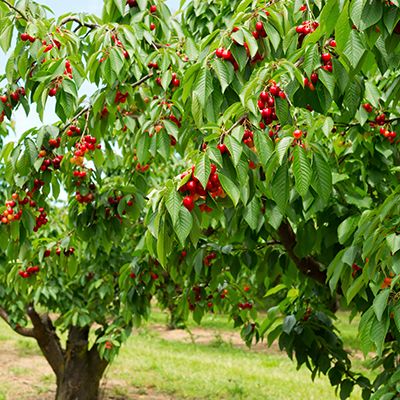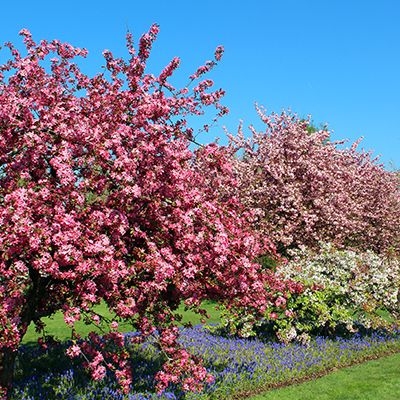


Cherry Trees
Prune: When completely dormant in December or January, remove about 10% of current season’s growth. To identify fruiting wood, see our Fruit Tree Pruning Care Guide.
Spray: Dormant spray in December or January after pruning with Master Nursery® Pest-Fighter Year-Round Spray Oil and Monterey Liqui-Cop®. Use four tablespoons of Monterey Liqui-Cop® mixed with six tablespoons of oil in one gallon of water.
Always check with your nursery professional to properly diagnose problems before undertaking additional sprays.
Brown Rot or Blossom Blight – (Different names for the same disease.)
Brown Rot is the most common and serious blossom and fruit disease of stone fruits. The first symptom is the browning and wilting of blossoms which may cling to the twigs for a long time. Cankers (sunken brown areas often develop at the base of the infected flowers. Sticky amber colored gum oozes from the base of the flowers or from the cankers. Prune and remove all diseased parts. The dormant season spray of Master Nursery® Year-Round Spray Oil and Monterey Liqui-Cop® should control the disease.
Bacterial Canker, or Bacterial Gummosis, or Bacterial Blast - (Different names for the same disease.) Is common and deadly and caused by Pseudomonas syringe. During the fall, winter and spring, the thin bark of young trees may appear nearly black and a clear, resinous gum exudes from cankers. In older trees, gumming may exude from many areas of the bark and extend up into the small branches often killing them. Splashing rain spreads the bacteria to dormant buds, twigs and branches. Infected blossoms turn brown and wilt; some leaf and flower buds may die. Other branches may fail to produce foliage and later die. The best treatment is to spray the entire tree with Monterey Liqui-Cop® with four tablespoons per gallon of water while it is dormant. Otherwise, removal of infected wood and flowers is the only treatment.
Shot Hole Fungus -
Spray: Spray trees again with Monterey Liqui-Cop® and Master Nursery® Year-Round Spray Oil at pink bud and full bloom stage.
Pruning: Prune to allow good ventilation.
Sanitation: Remove and destroy affected buds and blossoms during bloom. Remove and destroy maturing fruit when symptoms appear. In August or September, remove mummies and fallen fruit. Do not compost.
Irrigation Methods: Use basin or drip irrigation to avoid wetting blossoms, foliage and fruit.
Spotted Wing Fruit Fly (AKA Western Cherry Fruit Fly) -
Tiny fly (1/4” to 1/2”) lays eggs under skin of fruit as it is turning from yellow to pink.
Eggs hatch and maggots turn fruit dark and mushy.
Spray with Ortho® MAX® Malathion Insect Spray or Bonide© Captain Jack’s DeadBug Brew ® when fruit is starting to turn from yellow to pink (Malathion once and Spinosad three times one week apart).
Gather mushy fruit and dispose of it. Do not compost.
Sanitation: Remove and destroy infected buds and blossoms during bloom, Remove and destroy maturing fruit when symptoms appear. In August or September, remove and destroy mummies and fallen fruit.
Irrigation Methods: Use basin or drip irrigation to avoid wetting blossoms, foliage and fruit.
Fertilize: Use Master Nursery® Fruit Tree & Vine Food twice a year: around Memorial Day and Labor Day. If you prefer organic fertilizers, use Gardner & Bloome® Citrus & Fruit Tree Fertilizer two to three weeks earlier. Water in immediately after application. Supplement organic fertilizers with Iron Sulfate to prevent chlorosis.
Water: Plant cherries in well-drained soils away from lawns. Excessive water or poorly drained soils increase the incidence of root and crown rots, to which cherries are prone. Keep trunk and soil at the base of the tree dry during irrigation. At planting, construct a soil berm at the dripline of the tree. As the tree matures, extend the berm to the span of the drip line. Flood weekly during the first year and then at two to four-week intervals when the tree is mature. If a drip system is used, place hosing along the tree’s dripline with emitters on 12 to16 inch centers. This system will also need to be adjusted as the drip line expands. Do not use sprinklers to irrigate cherry trees; you want to avoid wetting blossoms, foliage and fruit.
Other Comments: Many cherries are not self-fruitful and require a pollinizer to ensure good crops.
Check with one of Wegman’s staff to determine your needs.
Watch for gummosis (amber-colored gum on branches and stems) and borer damage, which will cause gummosis near the base of the trunk at the graft union. Bring several leaf and twig samples to Wegman’s Nursery for evaluation whenever these or other symptoms appear.
Cherry trees sunburn easily. Apply a one to one mixture of white interior latex paint and water to prevent sunburn injury and reduce borer infestations. Apply the paint mixture from two inches below the soil surface to three feet above or to the lowermost scaffold branches.
Adapted from Ogawa and English (1991), Diseases of Temperate Zone Tree Fruit & Nut Crops, UC Extension Publication 3345 and Flint (1998), Pests of the Garden and Small Farm, 2nd Ed., UC Extension Publication 3332.